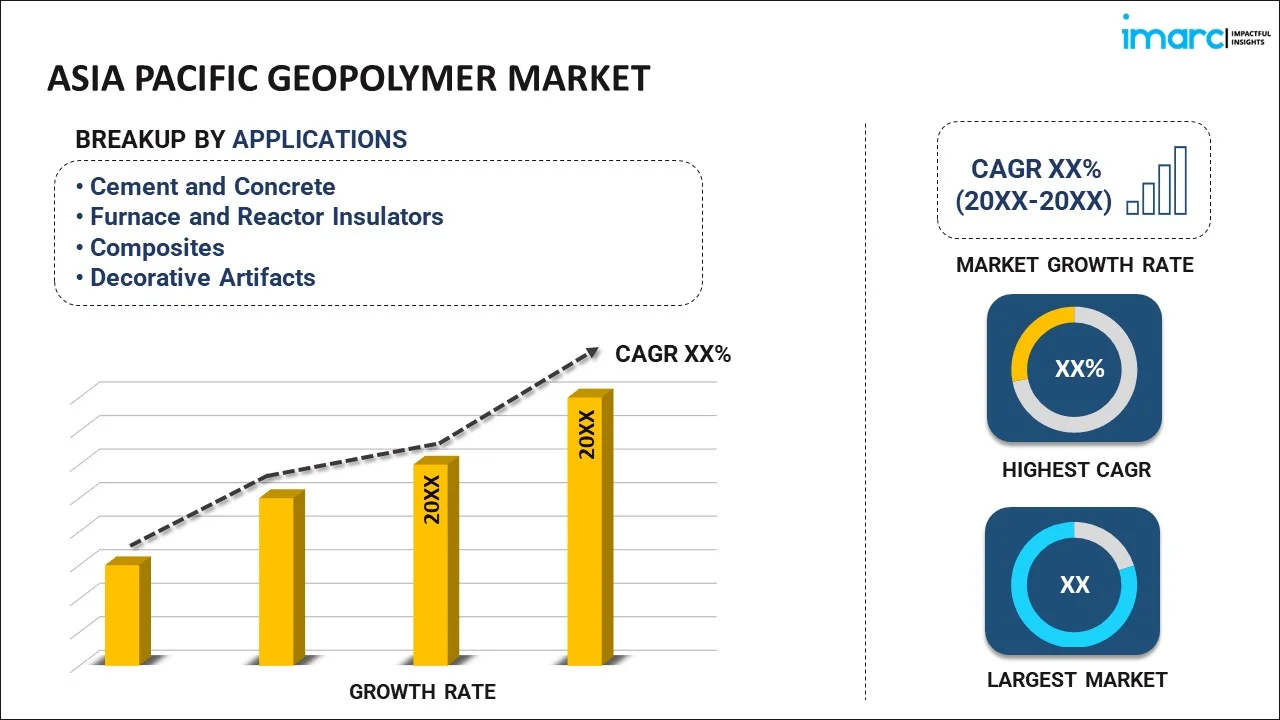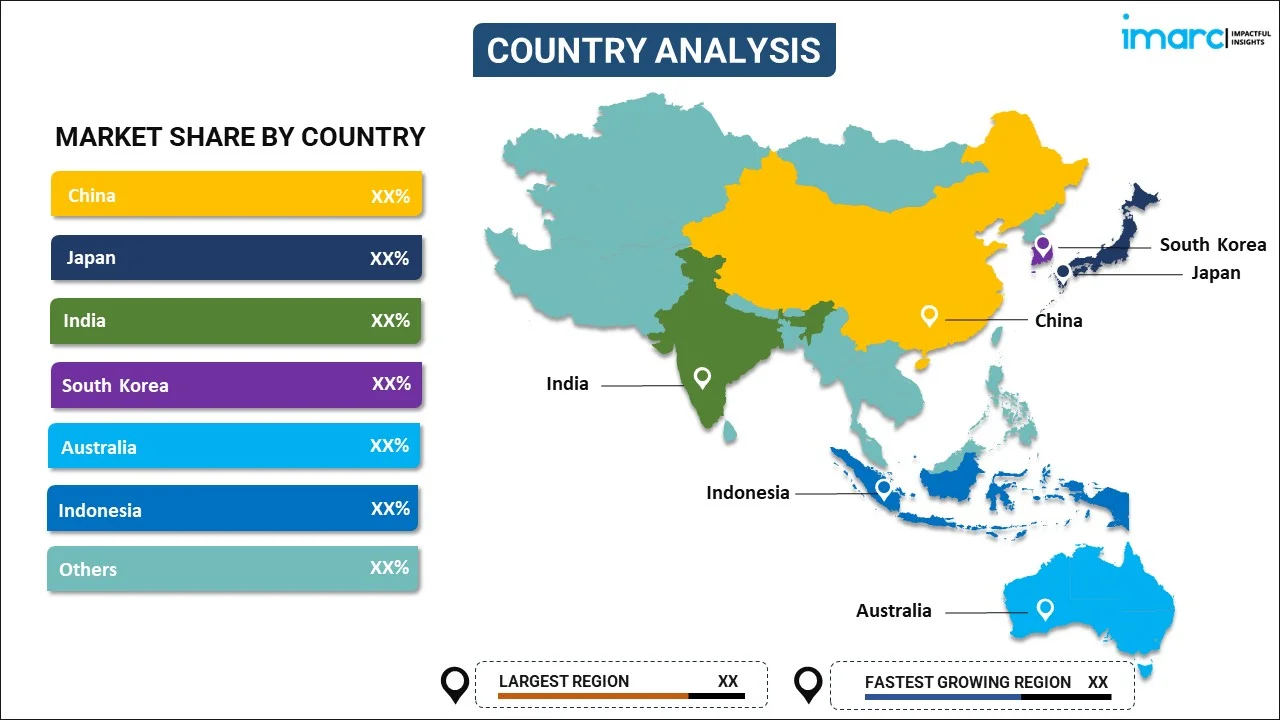
Asia Pacific Geopolymer Market Report by Application (Cement and Concrete, Furnace and Reactor Insulators, Composites, Decorative Artifacts), End Use Industry (Building Construction, Infrastructure, Industrial, Art and Decoration, and Others), and Country 2025-2033
Market Overview:
The Asia Pacific geopolymer market size reached USD 6.0 Billion in 2024. Looking forward, IMARC Group expects the market to reach USD 27.6 Billion by 2033, exhibiting a growth rate (CAGR) of 17.67% during 2025-2033.
|
Report Attribute
|
Key Statistics
|
|---|---|
|
Base Year
|
2024 |
|
Forecast Years
|
2025-2033
|
|
Historical Years
|
2019-2024
|
| Market Size in 2024 | USD 6.0 Billion |
| Market Forecast in 2033 | USD 27.6 Billion |
| Market Growth Rate (2025-2033) | 17.67% |
Geopolymers refer to inorganic ceramic materials characterized by a network of mineral molecules linked with covalent bonds. They are obtained naturally, like obsidian, and can also be synthesized chemically in a laboratory. They are produced by reacting an aluminosilicate powder with a highly concentrated alkali solution and can act as a binder for different fillers, producing various composite materials. Geopolymers have an amorphous microstructure at room temperature that provides high resistance and thermal insulation. They also offer numerous advantages such as high strength, ultra-porosity, low drying shrinkage, low creep and acid resistance. As a result, geopolymers are utilized for fire and heat resistant coatings and adhesives, medicinal applications, high-temperature ceramics, and toxic and radioactive waste encapsulations.
The Asia Pacific geopolymer market is primarily driven by rapid urbanization, which has resulted in an increasing number of power plants. Most of the electricity in the Asia Pacific region is derived from coal, which represents over half of the power mix. Due to this, the current emphasis is on developing novel low-CO2 binders, such as geopolymers, to lower the emissions. Geopolymers are also used as a binder in concrete as they are cost-effective and environment-friendly substitutes, which emit lesser carbon dioxide emissions than Portland cement. Consequently, they are extensively used for repairing bridges, tunnels, roads, and pipes for civil infrastructures. Furthermore, various environmental regulations and emission strains on the cement industry, coupled with the technological developments and innovations in the construction industry, are bolstering the market growth.
Key Market Segmentation:
IMARC Group provides an analysis of the key trends in each segment of the Asia Pacific geopolymer market report, along with forecasts at the regional and country levels from 2025-2033. Our report has categorized the market based on application and end use industry.
Breakup by Application:

- Cement and Concrete
- Furnace and Reactor Insulators
- Composites
- Decorative Artifacts
Breakup by End Use Industry:
- Building Construction
- Infrastructure
- Industrial
- Art and Decoration
- Others
Breakup by Country:

- China
- Japan
- India
- South Korea
- Australia
- Indonesia
- Others
Competitive Landscape:
The competitive landscape of the industry has also been examined along with the profiles of the key players.
Report Coverage:
| Report Features | Details |
|---|---|
| Base Year of the Analysis | 2024 |
| Historical Period | 2019-2024 |
| Forecast Period | 2025-2033 |
| Units | Billion USD |
| Segment Coverage | Application, End-Use Industry, Country |
| Countries Covered | China, Japan, India, South Korea, Australia, Indonesia, Others |
| Customization Scope | 10% Free Customization |
| Post-Sale Analyst Support | 10-12 Weeks |
| Delivery Format | PDF and Excel through Email (We can also provide the editable version of the report in PPT/Word format on special request) |
Key Questions Answered in This Report:
- How has the Asia Pacific geopolymer market performed so far and how will it perform in the coming years?
- What has been the impact of COVID-19 on the Asia Pacific geopolymer market?
- What are the key regional markets?
- What is the breakup of the market based on the application?
- What is the breakup of the market based on the end use industry?
- What are the various stages in the value chain of the industry?
- What are the key driving factors and challenges in the industry?
- What is the structure of the Asia Pacific geopolymer market and who are the key players?
- What is the degree of competition in the industry?
Need more help?
- Speak to our experienced analysts for insights on the current market scenarios.
- Include additional segments and countries to customize the report as per your requirement.
- Gain an unparalleled competitive advantage in your domain by understanding how to utilize the report and positively impacting your operations and revenue.
- For further assistance, please connect with our analysts.
 Inquire Before Buying
Inquire Before Buying
 Speak to an Analyst
Speak to an Analyst
 Request Brochure
Request Brochure
 Request Customization
Request Customization




.webp)




.webp)












